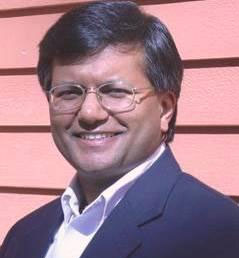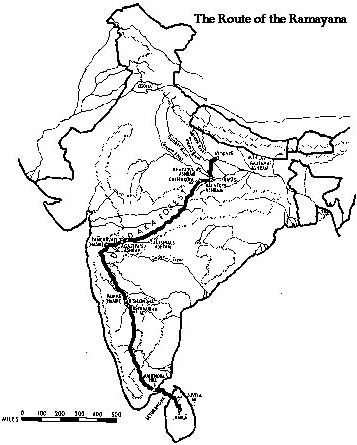Contribute
| Historical Basis Of Ramayana |
Niraj Mohanka
08/05/2008
Valmiki Ramayana is the "aadi" (original) Ramayana. Most of the scholars agree on the matter that Valmiki Ramayana originally consisted of five parts starting from the Ayodhya kanda chapter to Yudhya kanda chapter whereas the Bal-kanda and the Uttar-kanda chapters in Ramayana were additions at a later stage.
Rama is mentioned in the last book of the RV – X.93, 14. Since Mandala 10 of the RigVeda was chronologically the last and likely was composed from 2200 to 1700 BCE, this timeframe makes sense since according to other corroborative evidence Rama probably lived around 2100 BCE.
I post below an article by Nanditha Krishna:
To look at the historical basis for Ramayana Ayodhya plays a central part and the ongoing controvery over the Babri Masjid. Was there a temple before the mosque? Archaeologists would have to answer that. Was Rama born there? The answer is a matter of belief. Did Rama exist? Yes, I am quite sure he did. Rama’s life was a fact. His divinity is a matter of faith.
To doubt the existence of Rama is to doubt all literature. There is no archaeological or epigraphic evidence for either Jesus Christ or Prophet Mohammed, who are known only from the Bible and Koran respectively. Does it mean they did not exist? If Rama performs miracles such as liberating Ahalya, the Biblical story of Jesus walking on water or the Koranic tale of Mohammed flying to heaven on a horse are equally miraculous. Such stories reinforce divinity, not fact.
The Ramayana starts with Valmiki asking Narada who was the greatest man who ever lived. Narada narrates the story of Rama, king of Ayodhya, in a few terse, factual lines. Valmiki then goes on to elaborate the story in poetry, creating the Ramayana. Creativity distinguishes the epic from Narada’s news report.
The Ramayana is geographically very correct. Every site on Rama’s route is still identifiable and has continuing traditions or temples to commemorate Rama’s visit. Around 1000 BC, no writer had the means to travel around the country inventing a story, fitting it into local folklore and building temples for greater credibility.
In 1975 the Archaeological Survey of India (ASI) unearthed fourteen pillar bases of kasauti stone with Hindu motifs near the mosque at Ayodhya; reports of the excavations are available with the ASI. Rama was born in Ayodhya and married in Mithila, now in Nepal. Not far from Mithila is Sitamarhi, where Sita was found in a furrow, still revered as the Janaki kund constructed by her father Janaka. Rama and Sita left Mithila for Ayodhya via Lumbini. In 249 BC, Ashoka erected a pillar in Lumbini with an inscription referring to the visits by both Rama and Buddha to Lumbini. Ashoka was much nearer in time to Rama and would be well aware of his facts.
Rama, Lakshmana and Sita left Ayodhya and went to Sringaverapura — modern Sringverpur in Uttar Pradesh — where they crossed the River Ganga. They lived on Chitrakoot hill where Bharata and Shatrughna met them and the brothers performed the last rites for their father. Thereafter, the three wandered through Dandak-Aranya in Central India, described as a land of Rakshasas, obviously tribes inimical to the brothers’ habitation of their land. Tribals are still found in these forests. The trio reached Nasik, on the River Godavari, which throbs with sites and events of Rama’s sojourn, such as Tapovan where they lived, Ramkund where Rama and Sita used to bathe, Lakshmankund, Lakshmana’s bathing area, and several caves in the area associated with their lives in the forest.
Rama then moved to Panchavati near Bhadrachalam (AP), where Ravana abducted Sita. The dying Jatayu told them of the abduction, so they left in search of Sita. Kishkinda, near Hampi, where Rama first met Sugriva and Hanuman, is a major Ramayana site, where every rock and river is associated with Rama. Anjanadri, near Hospet, was the birthplace of Hanuman (Anjaneya); Sugriva lived in Rishyamukha on the banks of the Pampa (Tungabhadra); Sabari probably also lived a hermitage there. Rama and the Vanara army left Kishkinda to reach Rameshwaram, where the Vanaras built a bridge to Lanka from Dhanushkodi on Rameshwaram Island to Talaimannar in Sri Lanka. While parts of the bridge — known as Adam’s Bridge — are still visible, NASA’s satellite has photographed an underwater man-made bridge of shoals in the Palk Straits, connecting Dhanushkodi and Talaimannar. On his return from Sri Lanka, Rama worshiped Shiva at Rameshwaram, where Sita prepared a Linga out of sand. It is still one of the most sacred sites of Hinduism.
Sri Lanka also has relics of the Ramayana. There are several caves, such as Ravana Ella Falls, where Ravana is believed to have hidden Sita to prevent Rama from finding her. The Sitai Amman Temple at Numara Eliya is situated near the ashokavana where Ravana once kept her prisoner.
The presence of the Vanaras as ape-men, including Hanuman, has made the authenticity of the epic suspect. But this is the most plausible part of the story. The Vanaras were obviously tribes with the monkey totem: after all, the Ramayana belongs to a period when most of India was jungle with tribal forest-dwellers. India still contains several tribes with animal totems. An early issue of the Bellary District (now in Karnataka) Gazetteer gives us the interesting information that the place was inhabited by the Vanara people. The Jaina Ramayana mentions that the banner of the Vanaras was the vanaradhvaja (monkey flag), thereby reinforcing the totemic theory.
Similarly, Jatayu would have been the king of the vulture-totem tribe and Jambavan of the bear-totem tribe.
On the other hand was the Vanaras or ape-men a species in between Man and Ape, which is now extinct. Either way this would be a totally separate topic.
Was Lanka the modern Sri Lanka? One school of thought places Lanka on the Godavari in Central India, citing the limited descriptions of the South in the latter half of the epic. Narada does not mention Panchavati or Rameshwaram, but refers to Kishkinda and Lanka. Living in the north, it is unlikely that Valmiki knew the south. But Valmiki would know the difference between a sea and a river. Lanka, says the author definitively, was across the sea.
All the places visited by Rama still retain memories of his visit, as if it happened yesterday. Time, in India, is relative. Some places have commemorative temples; others commemorate the visit in local folklore. But all agree that Rama was going from or to Ayodhya. Why doubt connections when literature, archaeology and local tradition meet? Why doubt the connection between Adam’s Bridge and Rama, when nobody else in Indian history has claimed its construction? Why doubt that Rama traveled through Dandakaranya or Kishkinda, where local non-Vedic tribes still narrate tales of Rama? Why doubt that he was born in and ruled over Ayodhya?
Major settlements, including temples, were renovated several times: restoration is a 20th century development. When the main image was made of perishable materials, it was replaced by stone. For example, we know that the wooden image of Varadaraja Perumal of Kanchipuram was replaced by a stone image, for the earlier image is still preserved in a water tank. The present architecture belongs to the sixteenth century Vijayanagara style. Yet the temple was known to have existed before the Pallava period (seventh century). This is the story of many sacred sites in India. This happened to several Rama temples too.
Rama’s memory lives on because of his extraordinary life and his reign, which was obviously a period of great peace and prosperity, making Ramarajya a reference point. People only remember the very good or the very bad. Leftist historians have chosen to rubbish archaeology, literature and local tradition.
You may also access this article through our web-site http://www.lokvani.com/


Map Journey of Rama